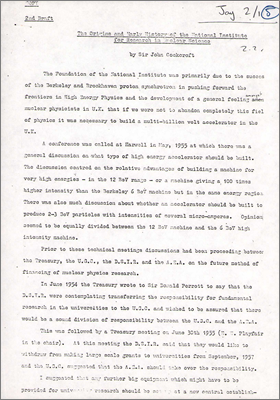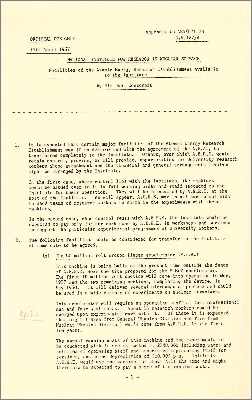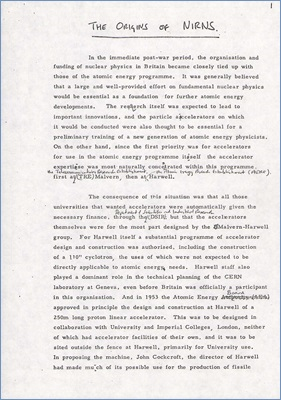The neutron project and the beginning of NIRNS
Our archives contain a variety of material relating to the Neutron Project and the machine which became known as Nimrod.
The Neutron Project (May 1954)

|
AEX(54)98: A paper for the Technical Steering Committee of the Atomic Energy Executive (AEX). Paper also referred to as TSC(54)11.
This paper discusses the need for a neutron source in order to measure neutron cross sections and reaction rates more accurately. It considers possible solutions such as a linear accelerator, cyclotron or reactor and concludes that they need a more powerful electron linac -- more than 30 MeV compared to the 15 MeV they had at the time.
The paper is marked "Secret" and talks about cores and tampers which are nuclear weapons terminology. Although it mentions making better reactors the authors might be mostly interested in the neutron cross sections to better understand their bombs. The paper is dated May 1954 and they mention the US AEC in several places. (The AEC headed by Lewis Strauss is currently grilling Oppenheimer.)
We believe that they did build this new electron linac, and donated the old one to Cambridge just as the document suggests they might.
(Comments from AL, ISIS)
|
A symposium upon machines for high energy physics in the UK (May 1955)

|
A one-and-a-half day meeting held on Friday 13th and Saturday 14th May 1955 in the New Lecture Theatre (later the Cockcroft Lecture Hall), Harwell.
Chaired by John Cockcroft, the meeting included presentations by Rudy Peierls (Oxford), Philip Moon (Birmingham),
Gerry Pickavance (later Director of Nimrod), John Lawson and Bill Walkinshaw (Harwell),
and a recorded presentation by John Adams (CERN).
A visit to the building site of the Proton Linear Accelerator (PLA) was organised for the Friday evening.
From the notes "Saturday only" and "Friday only" it is assumed that the list of attendees applies to this meeting as the papers were kept together, albeit unfastened. |

|
John Adams outlines the difficulties of building a large alternating gradient proton synchrotron, and discusses various design and management problems.


|

|
Summary of proceedings (Gerry Pickavance, 27 June 1955). |
Update following a symposium upon machines for high energy physics in the UK (December 1955)
A follow-up progress meeting held in December, again chaired by John Cockcroft. The discussions were recorded.
(The original 1955 reel-to-reel tapes were re-recorded onto cassette in 1982; the tape/side numbering scheme is curious.)
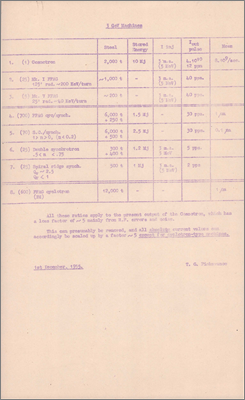
|
Gerry Pickavance produced a comparison sheet of 3 GeV machines in preparation for the meeting.
|


|
Tape 1: Sir John Cockcroft summarises progress since the May meeting and Dr Gerry Pickavance reports on the status of the AERE design study.
|


|
Tape 2 sides 1 and 2: Prof Hans Bethe reviews High Energy Physics and Mr John Dickson reports on the high energy machine programme in the United States.
|


|
Tape 2 sides 3 and 4: General discussion.
The main issues were for an electron or proton machine, then the required energy and intensity. In those days, all that was considered was a fixed target programme with bubble chambers and electronic detectors. There were already proton accelerators providing prolific beams of pions in the USA; this work had led them to consider the pion to be well understood, at least in its external properties, though as yet no hints of its composition. I think the most exciting challenge was considered to be to replicate such a programme for the K mesons and hyperons, recently discovered in cosmic ray showers. They do talk about antiprotons, but I think the big mystery of the day was the character of the strange particles. They were confident of providing sufficiently intense beams of K+ and K- with a proton accelerator of 3 GeV, and eventually concluded they could push to 7 GeV with the conventional Constant Gradient (CG) design, as opposed to the Alternating Gradient (AG) design which was being pioneered at CERN (the PS) and Brookhaven (the AGS). While AG machines should reach what they called super-high energies of around 20 GeV, there were many challenges as graphically described in John Adams's talk, and severe doubts about achieving a useful intensity. By the end of 1955 they reached agreement (unanimously I think) to push for a CG proton accelerator of intensity at least 100 times greater than at the Bevatron. Several people (including Bethe) were dubious that there would be much of interest in the super-high energy regime which would be far above the "resonance region" and in the (structureless?) continuum. Of course, once the AGS and CERN PS started operating it wasn't long before discoveries such as the Omega-minus and the muon neutrino established the importance of this energy range for particle physics, and in the intervening decades we have progressed step by step, so that few physicists today would doubt the exciting prospects for 100 TeV p-p collisions in the FCC, if the feasibility studies prove to be successful.
The approach of high intensity at moderate energy did indeed pay off, and Nimrod and the Argonne ZGS played a big part in fleshing out the baryon and meson spectra that provided some of the essential foundations of what became the Standard Model of Particle Physics. It's also true that, once the PS and AGS were running, it was unanimously agreed that one would never again build a CG machine. (CD, August 2024)
|
Notes on the High Energy Accelerator Programme (1956?)
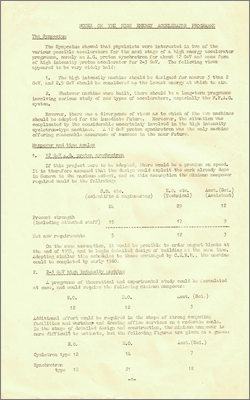
|
A paper that mentions "The Symposium" discussing views on which accelerator design to adopt.
|
On the creation of a National Institute for Nuclear Physics (1956)
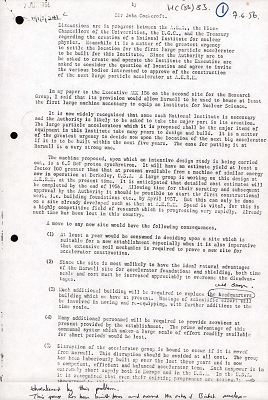
|
HC(56)83: A paper written by John Cockcroft for AEX (Atomic Energy Executive) discussing the location of the new institute and accelerator.
|
Proposals for a National Institute for Research in Advanced Nuclear Science (1956)

|
HC(56)139: A paper submitted to Ministers by Sir John Cockcroft discussing the cost of nuclear physics research and the proposal for a national research institute.
|
Proposal for a 6.5 GeV then 7.0 GeV accelerator (5 June and 18 September 1956)
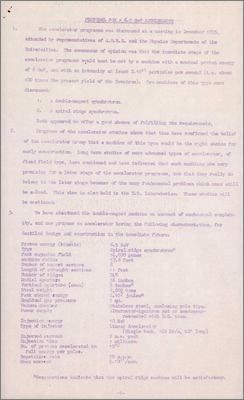
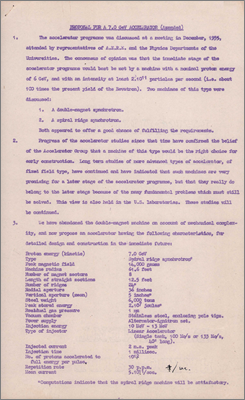
|
Notes from TG Pickavance referring to the meeting in December 1955 and discussion concerning a double-magnet synchrotron design which has now been ruled out as too complex, and a spiral-ridge synchrotron for which he lists some likely characteristics; revised a few months later.
|
Early history of NIRNS and Rutherford High Energy Laboratory
